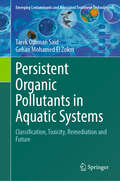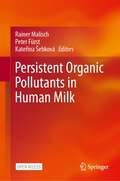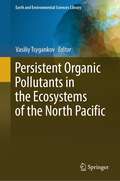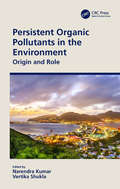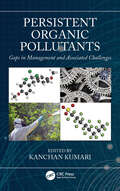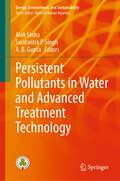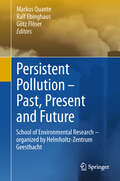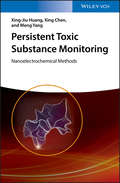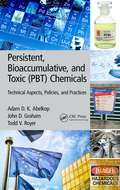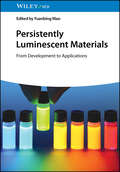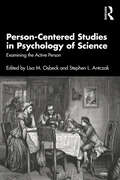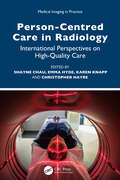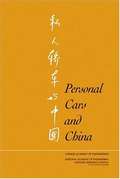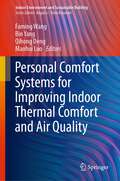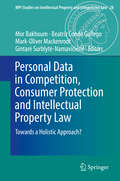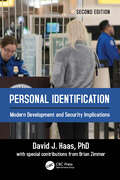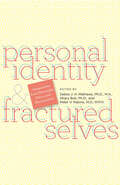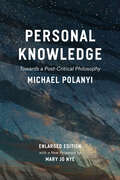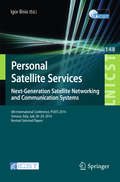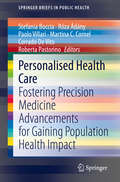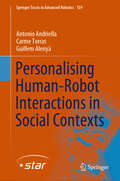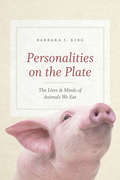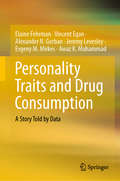- Table View
- List View
Persistent Organic Pollutants in Aquatic Systems: Classification, Toxicity, Remediation and Future (Emerging Contaminants and Associated Treatment Technologies)
by Gehan Mohamed El Zokm Tarek Othman SaidThis book addressed an in-depth comprehension of the classifications and characterizations of POPs, which have become global issues due to bioaccumulation, persistency, and toxicity. It represents the milestones of the development of pesticide application, industry, and management. Banned SC-POPs have special investigations. It discusses air-sea exchange, ocean currents, phase distribution, speciation, adsorption, desorption, and degradation as the key processes that control POP's fate. The book explores several aspects of POP chemistry that have a direct influence on their biochemical and toxicological consequences. The book illustrates the dynamic equilibriums influencing the proportion of a POP's gaseous, liquid, and solid phases. The book discussed POP migration by referring to the grasshopper effect. It also explores the impacts of climate change on emissions and the fate of POPs through a global-scale multimedia fate model. Additionally, it displays the impact of potential global change scenarios on POP bioaccumulation patterns. The book is directed at giving a deep discussion of the method's QA/QC process for POP determination and has verified the accuracy and precision of the procedures. As a distinctive point, it discusses many aspects concerning the toxicity of POPs. It reports mechanisms describing the toxicity of POPs on immune systems, carcinogenesis, endocrine, neural, and reproductive systems. The book keeps an eye on a model describing the global distribution and toxicity of PAHs. Among the exclusive points in the book is the evaluation of the recent ecological status in Egypt relative to POPs through a time-scale overview and recent case studies. It provides thematic literature related to DDC research in Africa through the WoS and Scopus databases from 1949 to 2021. The book emphasizes models for predicting the annual contribution rate of POPs as a way to raise public awareness about POPs. The greatest challenge for the book is how to motivate the audience to be aware of these hazardous materials in marine ecosystems. Moreover, this book will be of great interest to academics, professionals, practitioners, post-graduate students, and undergraduates because it gives a clear overview of POPs in the marine environment. It also provides decision-makers with a realistic perspective of the environmental file, allowing them to address environmental issues and directing stockholders to safer locations for environmental activity. From a future perspective, the regulation of pervasive POPs, with special reference to recently evaluated harmful substances (PFASs), has faced significant challenges in the wake of pressure from regulators.
Persistent Organic Pollutants in Human Milk
by Peter Fürst Rainer Malisch Kateřina ŠebkováThis open access book reviews the trends of persistent organic pollutants (POPs) in human milk and discusses the main findings of five global surveys that were coordinated by the World Health Organization (WHO) and the United Nations Environment Programme (UNEP) from 2000 to 2019. Human milk was selected as core matrix for human exposure under the Global Monitoring Plan for effectiveness evaluation of the Stockholm Convention on Persistent Organic Pollutants. Milk from well-defined groups of mothers was collected and mixed to form a representative sample per country. Datasets collected represent the largest global human tissues survey with a harmonized protocol, carried out in a uniform format for more than two decades. Altogether 69 countries participated in these studies between 2000 and 2015, and more than 40 countries participated in the study from 2016 to 2019.Divided into 5 parts, the book offers an authoritative overview of human milk biomonitoring; collates the harmonized sampling requirements and analytical methods for the identification and quantification of contaminants in human milk; examines the results of the WHO/UNEP-coordinated exposure studies, including the identification of selected chlorinated pesticides, dioxin-like compounds, industrial chemicals like polychlorinated biphenyls (PCB) and chlorinated paraffins, polybrominated POPs and PFAS, among others; and traces geographic, temporal and cross-substance trends and correlations, and human health risks. The book finishes by providing the reader with the summary of the main findings and outlook from these studies, in which the comparison of concentrations found for the wide range of POPs listed in the Stockholm Convention allowed the identification of possible needs for actions and follow-ups in different countries/regions. This book contributes to the understanding of exposure to hazardous chemicals and pollution as addressed by the UN Sustainable Development Goals on Good Health and Well-being (SDG 3) and will appeal to environmental and analytical chemists, researchers, professionals, and policymakers interested in learning more about contaminants in human milk. Given its breadth, this book will also appeal to a broader audience interested in maternal and child health.
Persistent Organic Pollutants in the Ecosystems of the North Pacific (Earth and Environmental Sciences Library)
by Vasiliy TsygankovThe book reports the results on the fate of POPs in the abiotic and biotic components of the aquatic environment North Pacific Ocean (include Russian part of North Pacific), possible health risks for coastal residents Pacific Ocean exposed to these hazardous pollutants are systematized. In particular, indicator organisms (fish, birds, and mammals), indicating the pollution of the region, were identified; the possible ways of xenobiotic transfer from the sea to the land are shown; the targets of POPs impact on living organisms were determined; the time of circulation of pollutants in the biosphere was determined; a list of “priority” toxicants for the region based on quality screening was compiled; the risks to human health from the consumption of contaminated aquatic organisms were assessed; the levels of POPs in the human body were measured. The book is interesting for specialists in the agro-industrial complex, aquaculture and medicine, teachers and graduate students of universities, researchers, which interested in the problems of persistent organic pollutants (POPs). There are no similar books on the study of POPs in the Russian part of the Pacific Ocean in the world literature. This book is useful to scientists of the world who study the fate of POPs.
Persistent Organic Pollutants in the Environment: Origin and Role
by Narendra KumarPersistent Organic Pollutants (POPs) are toxic, degradation resistant, bio accumulative, and display wide spatial distribution which has been linked to mutagenic, reproductive and immunological disorders. In Stockholm Persistent Organic Pollutants (POPs) are toxic, degradation resistant, bio-accumulative, and display wide spatial distribution, which has been linked to mutagenic, reproductive, and immunological disorders. At the Stockholm Convention, a global treaty was signed to minimize and ultimately eliminate the release of POPs into the environment. The present compilation regarding POPs focusses on the sources, atmospheric behavior, terrestrial and aquatic food chain transfer, human exposure, and fate aspects of this important class of chemicals, including topical issues like temporal trends in contamination. Furthermore, the chemical characteristics of individual POPs are also addressed. Features: Provides better understanding of Persistent Organic Pollutants (POPs) and how they affect humans and ecosystems. Includes genesis, categories, environmental fate and behavior, and associated hazards. Reviews analytical techniques involved in detection, human exposure and management. Discusses environmental dynamics of POPs. Focuses on the comprehensive account of PCDD/Fs, PCBs, PAH and other organochlorine POPs, such as DDT, lindane, and dieldrin. This book is aimed at researchers, professionals and graduate students in Life Science, Occupational Health and Safety, Chemical Engineering and Environmental Engineering.
Persistent Organic Pollutants: Gaps in Management and Associated Challenges
by Kanchan KumariPersistent Organic Pollutants (POPs) are chemicals that resist environmental degradation and cause deleterious effects on the environment and human wellbeing. Once released into the environment they can travel long distances and persist for longer duration. This book highlights the complex area of POPs in simple language and deals with the fundamentals of the chemicals, their sources, and impacts on human health. The book also unfolds several other aspects like new and advanced analytical detection methods, gaps in management, effectiveness of the Stockholm convention, and the role of the global monitoring plan on POPs for crucial and holistic understanding about POPs. It also investigates how to minimize the impact of POPs and the major gaps and challenges in sound management of POPs. With its comprehensive approach, this book is an indispensable source of knowledge for those studying and working to mitigate the effect of POPs in the environment.
Persistent Pollutants in Water and Advanced Treatment Technology (Energy, Environment, and Sustainability)
by Alok Sinha Swatantra P. Singh A. B. GuptaThis contributed volume discusses the current status of the occurrences, fate and transport of persistent pollutants in water and wastewater. This contents compile the state-of-the-art of emerging technologies such as nanotechnology, advanced oxidation process, membrane processes, sorption, etc. for the clean-up of persistent pollutants in water including heavy metals, pharmaceuticals, phenolic compounds as well as microplastics and their by-products. This volume will be useful as a guide for the researchers to build strategies to deal with persistent pollutant. It also discusses the principal aspects of degradation mechanism of the pollutants, toxic by-products and effectiveness of the emerging technologies. This volume will be a useful guide for those working in soil and water protection, and environmental civil engineering.
Persistent Pollution – Past, Present and Future
by Götz Flöser Markus Quante Ralf EbinghausThis book evolved from the 5th School of Environmental Research entitled "Persistent Pollution - Past, Present and Future", which has set a focus on Persistent Organic Pollutants (POPs), heavy metals and aerosols. - reconstruction of past changes based on the scientific analysis of natural archives such as ice cores and peat deposits,- evaluation of the present environmental state by the integration of measurements and modelling and the establishment of cause-effect-patterns,- assessment of possible environmental future scenarios including emission and climate change perspectives.
Persistent Toxic Substance Monitoring: Nanoelectrochemical Methods
by Xing-Jiu Huang Xing Chen Meng YangFilling the urgent need for a professional book that specifies the applications of nanoelectrochemistry for the monitoring of persistent toxic substances, this monograph clearly describes the design concept, construction strategies and practical applications of PTS sensing interfaces based on nanoelectrochemical methods. The comprehensive and systematic information not only provides readers with the fundamentals, but also inspires them to develop PTS monitoring sensors based on functional nanostructures and nanomaterials. Of interestto chemists, electrochemistry researchers, materials researchers, environmental scientists, and companies dealing with electrochemical treatment and environment.
Persistent, Bioaccumulative, and Toxic (PBT) Chemicals: Technical Aspects, Policies, and Practices
by John D. Graham Adam D. Abelkop Todd V. RoyerDeveloped from the efforts of a multiyear, international project examining how persistent, bioaccumulative, and toxic (PBT) chemicals are evaluated and managed, Persistent, Bioaccumulative, and Toxic (PBT) Chemicals: Technical Aspects, Policies, and Practices focuses on improving the processes that govern PBTs. Incorporating science and policy literature—as well as interviews and panel discussions featuring experts from around the world—this book provides you with an international perspective of PBT policies (centering on Europe, Asia, and North America), and reveals major findings and recommendations for improving PBT science, laws, and policies. It includes case studies of specific chemicals, provides an introduction to the overall subject of toxic chemicals, and weighs in on science and policy expansion for PBTs. It also provides summary tables of important PBTs, and discussions on the number of PBTs in commerce, weight of evidence approaches, market deselection, and international management.The text: Assesses the history, current practice, and future of PBT management Considers the roles scientific data, modeling, and conventions play in identifying and regulating PBTs Explores the number of PBTs in commerce and the growing role of weight of evidence (WOE) in the making of PBT determinations Identifies issues that are likely to come up in WOE judgments Examines international, national, subnational, and regional PBT policies Includes a comprehensive and easy-to-understand analysis of PBT science and policy This book reviews the current science, policies, and practices surrounding the regulation of PBTs. It also provides relevant research, recommendations, and suggestions for improving the management and oversight of PBTs.
Persistently Luminescent Materials: From Development to Applications
by Yuanbing MaoA broad view of the booming field in optical materials based on their applications and potentials. Persistent luminescence refers to a property of materials in which they retain luminescence for hours or even days without a source of excitation once being charged. Persistently luminescent materials have found a huge range of technological applications, from optical displays to chemical sensing to information storage and security technologies. This growing field of research and development has never been such an important area of materials science. Persistently Luminescent Materials offers a comprehensive overview of these emerging optical materials and their applications. It presents all major research trends, new information, and novel properties of the major and developing persistently luminescent materials. With detailed information on how to design new materials and create new functionalities, it’s a must for researchers and technologists in virtually every major area of industry. Persistently Luminescent Materials readers will also find: Practical applications in phototherapy, biological imaging, displays, and more Detailed discussion of topics including sustainability techniques, temperature sensing, sterilization, and optical information storage Analysis of how to use persistently luminescent materials to create new theranostic functionalities Persistently Luminescent Materials is ideal for specialists and professionals in the field, but also for a broader readership seeking a perspective of practical needs related to the applications of optical and perticularly persistently luminescent materials.
Person-Centered Studies in Psychology of Science: Examining the Active Person
by Stephen L. Antczak Lisa M OsbeckThis unique collection examines "the acting person" as an important unit of analysis for science studies, using an integrative approach of in-depth case studies to explore the cognitive, social, cultural, and personal dimensions of a series of key figures in the sciences, from Goethe to Kepler to Rachel Carson. Opening up key questions about what science is, and what comprises a scientist, the volume offers an accessible introductory approach to psychology of science, a growing area in Science and Technology Studies (STS). Case studies focus on the psychological contexts of the contributions for which the scientist is known. Without diminishing its epistemic authority, science is presented as a psychologically saturated human activity, one that is especially illustrative of the way social, cognitive, and personal processes intermingle to both facilitate and impede scientific accomplishment. Each case study ends with a set of discussion questions, providing a valuable resource for student reflection and discussion, inviting analysis of similarities and differences in science in the context of very different lives and different projects. Person-Centered Studies in Psychology of Science is essential reading for scholars and graduates interested in the psychology of science, personality theory, social, or cognitive psychology, general psychologists, and theoretical psychologists.
Person-Centred Care in Radiology: International Perspectives on High-Quality Care (Medical Imaging in Practice)
by Karen Knapp Christopher Hayre Emma Hyde Chau, Edited by ShayneThis edited book focuses on the application of patient care within the three specialisms: diagnostic radiography (including fluoroscopy, computed tomography, breast imaging, ultrasound, and magnetic resonance imaging), radiotherapy and oncology, and nuclear medicine and molecular imaging.Person-Centred Care in Radiology: International Perspectives on High-Quality Care draws from recent publications and clinical expertise, supported with this trend of technological advances and how they are supposed to enhance patient care. The chapters seek to uncover the role and behavior of radiographers. This will be supported with chapters on a key aspect, which will impact both radiographers and patients, vis-à-vis advancing technology. These chapters include topics such as artificial intelligence, image acquisition, coincided with topics surrounding ethics. The edited volume includes contributions from the United States, Canada, the UK and Australasia to bring together for the first time those at the forefront of this growing field in medical imaging.This book may be used to influence policymaking decisions and thus influence how healthcare delivery is offered in an ever-evolving imaging environment. In short, this text bridges the gap between what is advocated in the literature, with experience, as observed in practice. The targeted audience for this book is multifaceted. It will primarily be a book that facilitates undergraduate radiography students worldwide. It will offer a useful tool for academics delivering undergraduate (pre-registration) radiography programs.This book will act as a ‘primer’ for undergraduate students, but importantly ‘signpost’ to other key texts within the field. Further, academics will find this text useful as it aims to enrich scholarly learning, teaching and assessment to healthcare programs nationally and internationally.
Personal Cars and China
by Zhongguo Gong Cheng Yuan Staff National Research Council (U.S.) StaffThis collaborative study between the NRC and the Chinese Academy of Engineering (CAE) addresses the problems facing China in the next twenty years as it attempts to provide personal transport desired by millions of Chinese, while preserving the environment and the livability of its cities. According to Song Jian, president of the CAE, the decision has already been taken to produce a moderate cost family car in China, which will greatly increase the number of vehicles on the roads. This study explores the issues confronting the country, including health issues, the challenge to urban areas, particularly the growing number of megacities, environmental protection, infrastructure requirements, and technological options for Chinese vehicles. It draws on the experience of the United States and other countries and review model approaches to urban transportation and land use planning. Recommendations and policy choices for China are described in detail.
Personal Comfort Systems for Improving Indoor Thermal Comfort and Air Quality (Indoor Environment and Sustainable Building)
by Bin Yang Faming Wang Maohui Luo Qihong DengThis book first describes fundamental knowledge on human thermal comfort, adaptive thermal comfort, thermal comfort in sleeping environments, modeling of human thermal comfort, and thermal comfort assessment using human trials. Next, it presents an in-depth review of concept progress and evaluation of various personal comfort system, summarizes important findings and feasible applications, current gaps as well as future research needs. The seven chapters included in this section are task/ambient conditioning systems, personalized ventilation systems, electric fans, personal comfort systems, thermoelectric systems, personal thermal management systems, and wearable personal thermal comfort systems. This book provides valuable guidance for personal comfort system design and further improvement on the personal comfort performance. It will be a valuable resource for academic researchers, engineers in industry, and government regulators in the field of sustainable buildings and built environment.
Personal Data in Competition, Consumer Protection and Intellectual Property Law: Towards A Holistic Approach? (Mpi Studies On Intellectual Property And Competition Law Ser. #28)
by Mor Bakhoum Beatriz Conde Gallego Mark-Oliver Mackenrodt Gintarė Surblytė-NamavičienėThis book analyses the legal approach to personal data taken by different fields of law. An increasing number of business models in the digital economy rely on personal data as a key input. In exchange for sharing their data, online users benefit from personalized and innovative services. But companies’ collection and use of personal data raise questions about privacy and fundamental rights. Moreover, given the substantial commercial and strategic value of personal data, their accumulation, control and use may raise competition concerns and negatively affect consumers. To establish a legal framework that ensures an adequate level of protection of personal data while at the same time providing an open and level playing field for businesses to develop innovative data-based services is a challenging task.With this objective in mind and against the background of the uniform rules set by the EU General Data Protection Regulation, the contributions to this book examine the significance and legal treatment of personal data in competition law, consumer protection law, general civil law and intellectual property law. Instead of providing an isolated analysis of the different areas of law, the book focuses on both synergies and tensions between the different legal fields, exploring potential ways to develop an integrated legal approach to personal data.
Personal Identification: Modern Development and Security Implications
by David J. HaasPersonal Identification: Modern Development and Security Implications, Second Edition explains how personal identification – and REAL ID – became part of the American fabric along with their past century’s historical ID development. The development of the “trusted and secure” personal identification documents began with passports and has continued as social changes made IDs more essential. This book describes the convergence of technologies and hundreds of patents that produced our “trusted and secure” documents and IDs from our past right up through to today.Key factors, that created today’s need for public-issued mass ID, are addressed: Chronicles the effects of large and mobile populations beginning a century ago Chronicles the effects of “impersonal” electronic & computer communications at a distance, and not face-to-face The distribution of services and money by government agencies based on a person’s identity – including “age” and “group” criteria Describes recent national security and terrorism concerns that necessitates the need to know: “You are who you say you are.” Personal identification documents (IDs) and the societal need for “trusted” identification by the public is a relatively new social phenomenon. In 1900, most people did not need or have any IDs until passports, with a photograph of the individual, became mandatory when Great Britain entered World War I in 1914. In the United States, the State-issued driver’s license is probably the only trusted ID in one’s wallet today, but they became “trusted and secure” documents only recently with the requirement for REAL ID. With the first photo driver’s license issued by the State of Colorado in 1959, it took until 1984 for the last State (New York, 25 years later) to comply.As a direct result of 9/11, where terrorists used fake driver’s licenses to board planes, Congress passed the Real ID Act in 2005 to make all State-issued driver’s licenses more trusted, uniform, and tamper-resistant – what is now called the Enhanced Driver’s License with non-drivers being issued Enhanced Identification Cards. And with this, every US citizen can now possess a trusted and secure personal identification document.Personal Identification, Second Edition chronicles the path of personal identification measures – including the latest developments of Real ID. Scholars and professional security managers understand that stability, security, and safety necessitate these identity measures to ensure a safer America. The book explains the various stages and advances, providing readers with a unique study of this fascinating history of the relationship between identity and the means by which one validates and proves their own identity. The enactment of the REAL ID Act of 2005, with more secure and tamper-resistant documents for each citizen of the United States, is being instituted so that one can trust: “you are who you say you are.” The State-issued driver’s license is not a National ID Card – it is a Nationally Recognized ID for each citizen.
Personal Identity & Fractured Selves: Perspectives from Philosophy, Ethics, and Neuroscience
by Debra J. H. Mathews, Hilary Bok, and Peter V. RabinsIn this anthology, noted neurologists and philosophers explore the concept of personal identity and the ethics of treating brain disease and injury.When an individual’s personality changes radically because of disease or injury, should this changed individual be treated as the same person? Personal Identity and Fractured Selves explores this important question from a variety of perspectives. Its contents represent the first formal collaboration between the Brain Sciences Institute and the Berman Institute of Bioethics, both at the Johns Hopkins University.Rapid advances in brain science are expanding knowledge of human memory, emotion, and cognition and pointing the way toward new approaches for the prevention and treatment of devastating illnesses and disabilities. Through case studies of Alzheimer disease, frontotemporal dementia, deep brain stimulation, and steroid psychosis, the contributors highlight relevant ethical and social concerns that clinicians, researchers, and ethicists are likely to encounter.Contributors: Samuel Barondes, M.D., University of California, San Francisco; David M. Blass, M.D., Johns Hopkins University School of Medicine; Patrick Duggan, A.B., Johns Hopkins Berman Institute of Bioethics; Ruth R. Faden, Ph.D., M.P.H., Johns Hopkins Berman Institute of Bioethics; Michael S. Gazzaniga, Ph.D., University of California, Santa Barbara; Guy M. McKhann, M.D., Johns Hopkins University School of Medicine; John Perry, Ph.D., Stanford University; Carol Rovane, Ph.D., Columbia University; Alan Regenberg, M.Be., Johns Hopkins Berman Institute of Bioethics; Marya Schechtman, Ph.D., University of Illinois at Chicago; Maura Tumulty, Ph.D., Colgate University
Personal Identity and Fractured Selves: Perspectives from Philosophy, Ethics, and Neuroscience
by Debra J. H. Mathews, Hilary Bok, and Peter V. RabinsThis book brings together some of the best minds in neurology and philosophy to discuss the concept of personal identity and the moral dimensions of treating brain disease and injury. The contributors engage a crucial question: When an individual’s personality changes radically because of disease or injury, should this changed individual be treated as the same person?Rapid advances in brain science are expanding knowledge of human memory, emotion, and cognition and pointing the way toward new approaches for the prevention and treatment of devastating illnesses and disabilities. Through case studies of Alzheimer disease, frontotemporal dementia, deep brain stimulation, and steroid psychosis, the contributors highlight relevant ethical and social concerns that clinicians, researchers, and ethicists are likely to encounter. Personal Identity and Fractured Selves represents the first formal collaboration between the Brain Sciences Institute and the Berman Institute of Bioethics, both at the Johns Hopkins University. The book asks neuroscientists and philosophers to address important questions on the topic of personal identity in an effort to engage both fields in fruitful conversation. Contributors: Samuel Barondes, M.D., University of California, San Francisco; David M. Blass, M.D., Johns Hopkins University School of Medicine; Patrick Duggan, A.B., Johns Hopkins Berman Institute of Bioethics; Ruth R. Faden, Ph.D., M.P.H., Johns Hopkins Berman Institute of Bioethics; Michael S. Gazzaniga, Ph.D., University of California, Santa Barbara; Guy M. McKhann, M.D., Johns Hopkins University School of Medicine; John Perry, Ph.D., Stanford University; Carol Rovane, Ph.D., Columbia University; Alan Regenberg, M.Be., Johns Hopkins Berman Institute of Bioethics; Marya Schechtman, Ph.D., University of Illinois at Chicago; Maura Tumulty, Ph.D., Colgate University
Personal Knowledge: Towards a Post-Critical Philosophy
by Michael Polanyi Mary Jo NyeThe publication of Personal Knowledge in 1958 shook the science world, as Michael Polanyi took aim at the long-standing ideals of rigid empiricism and rule-bound logic. Today, Personal Knowledge remains one of the most significant philosophy of science books of the twentieth century, bringing the crucial concepts of "tacit knowledge" and "personal knowledge" to the forefront of inquiry. In this remarkable treatise, Polanyi attests that our personal experiences and ways of sharing knowledge have a profound effect on scientific discovery. He argues against the idea of the wholly dispassionate researcher, pointing out that even in the strictest of sciences, knowing is still an art, and that personal commitment and passion are logically necessary parts of research. In our technological age where fact is split from value and science from humanity, Polanyi's work continues to advocate for the innate curiosity and scientific leaps of faith that drive our most dazzling ingenuity. For this expanded edition, Polyani scholar Mary Jo Nye set the philosopher-scientist's work into contemporary context, offering fresh insights and providing a helpful guide to critical terms in the work. Used in fields as diverse as religious studies, chemistry, economics, and anthropology, Polanyi's view of knowledge creation is just as relevant to intellectual endeavors today as when it first made waves more than fifty years ago.
Personal Satellite Services. Next-Generation Satellite Networking and Communication Systems
by Igor BisioThis book constitutes the refereed post-conference proceedings of the 6th International Conference on Personal Satellite Services, PSATS 2014, held in Genova, Italy, in July 2014. The 10 revised full papers presented were carefully reviewed and present the latest advances in the next generation satellite networking and communication systems.
Personal Security: A Guide for International Travelers
by Tanya SpencerMaintain peace of mind while you are working or living abroad wherever and however you travel. As an international traveler, you know there are risks. But are you doing everything you can to protect yourself and your belongings? Whether you are traveling for work or pleasure, Personal Security: A Guide for International Travelers enables you to pre
Personalised Health Care: Fostering Precision Medicine Advancements for Gaining Population Health Impact (SpringerBriefs in Public Health)
by Stefania Boccia Paolo Villari Róza Ádány Martina C. Cornel Corrado De Vito Roberta PastorinoPractitioners are increasingly adopting a personalised medicine approach to individually tailored patient care, especially disease diagnosis and treatment with the use of biomarkers. However, development and implementation of such approaches to chronic disease prevention need further investigation and concerted efforts for proper use in healthcare systems. This book provides high-quality, multidisciplinary knowledge from research in personalised medicine, specifically personalised prevention of chronic disease. It addresses different perspectives of prevention in the field, and is the outcome of a four-year work of the Personalized prevention of Chronic Disease (PRECeDI) Consortium, a multi-disciplinary and multi-professional team of experts. The Consortium jointly agreed to document and address the five aspects or domains of personalised medicine and prevention as individual chapters: Identification of biomarkers for the prevention of chronic diseaseEvaluation of predictive genomic applicationsEthico-legal and policy issues surrounding personalised medicineRoles and responsibilities of stakeholders in informing healthy individuals on their genome: a sociotechnical analysisIdentification of organisational models for the provision of predictive genomic applicationsThe book focuses on the Consortium's recommendations that are derived from each of these domains based on up-to-date evidence and research that the authors write, follow, and systematically organise and report.Personalisation of health care is, eventually, a driver of innovation in research and healthcare systems. With this SpringerBrief on Personalised Health Care: Fostering Precision Medicine Advancements for Gaining Population Health Impact, the Consortium provides further evidence of the clinical validity and utility of personalised medicine with special emphasis on the prevention of chronic diseases. The book is a useful resource for policy makers, industry and healthcare professionals, scientists, technology-sector professionals, investors, citizens, and private companies that need proper advice to realise the potential of personalised medicine.
Personalising Human-Robot Interactions in Social Contexts (Springer Tracts in Advanced Robotics #159)
by Carme Torras Antonio Andriella Guillem AlenyàThis book offers an insightful exploration of the pivotal role of robots in our ever-changing society. As intelligent machines become increasingly integrated into various aspects of our lives, their impact on how we live, work, and interact becomes undeniable. Within these pages, the book delves into the key concept of personalisation, unravelling the profound importance of tailoring robotic interactions to meet the unique needs and preferences of individuals. This exploration seeks to foster a deeper understanding of how robots can enhance our lives and potentially be a worthwhile technology to address some important societal issues. To showcase that, the book centres on a practical use case that is built upon collaboration with healthcare experts: designing personalised robots for assisting patients affected by cognitive decline. With over 50 million people affected by dementia worldwide and an expected tripling of this number by 2050, the need for effective and accessible treatments is more pressing than ever. While there are no pharmacological treatments for this syndrome, cognitive training has shown promise for maintaining and even improving cognitive functioning among dementia patients. However, the shortage of healthcare professionals capable of delivering such therapy presents a significant challenge. This is where the potential of robots comes into play. This book delves into the potential of robotic technology designed to bridge this societal gap. By taking a therapist-oriented approach, it investigates the insights that can be gleaned from involving therapists in the entire pipeline of the design process as well as in the automatisation of the robots' assistive behaviour. Specifically, this book aims to address personalisation from two complementary perspectives by designing robots that are both adaptable and adaptive.
Personalities on the Plate: The Lives & Minds of Animals We Eat
by Barbara J. KingIn recent years, scientific advances in our understanding of animal minds have led to major changes in how we think about, and treat, animals in zoos and aquariums. The general public, it seems, is slowly coming to understand that animals like apes, elephants, and dolphins have not just brains, but complicated inner and social lives, and that we need to act accordingly. Yet that realization hasn’t yet made its presence felt to any great degree in our most intimate relationship with animals: at the dinner table. Sure, there are vegetarians and vegans all over, but at the same time, meat consumption is up, and meat remains a central part of the culinary and dining experience for the majority of people in the developed world. With Personalities on the Plate, Barbara King asks us to think hard about our meat eating--and how we might reduce it. But this isn’t a polemic intended to convert readers to veganism. What she is interested in is why we’ve not drawn food animals into our concern and just what we do know about the minds and lives of chickens, cows, octopuses, fish, and more. Rooted in the latest science, and built on a mix of firsthand experience (including entomophagy, which, yes, is what you think it is) and close engagement with the work of scientists, farmers, vets, and chefs, Personalities on the Plate is an unforgettable journey through the world of animals we eat. Knowing what we know--and what we may yet learn--what is the proper ethical stance toward eating meat? What are the consequences for the planet? How can we life an ethically and ecologically sound life through our food choices? We could have no better guide to these fascinatingly thorny questions than King, whose deep empathy embraces human and animal alike. Readers will be moved, provoked, and changed by this powerful book.
Personality Traits and Drug Consumption: A Story Told by Data (SpringerBriefs in Statistics)
by Alexander N. Gorban Jeremy Levesley Elaine Fehrman Vincent Egan Evgeny M. Mirkes Awaz K. MuhammadThis book discusses the psychological traits associated with drug consumption through the statistical analysis of a new database with information on 1885 respondents and use of 18 drugs. After reviewing published works on the psychological profiles of drug users and describing the data mining and machine learning methods used, it demonstrates that the personality traits (five factor model, impulsivity, and sensation seeking) together with simple demographic data make it possible to predict the risk of consumption of individual drugs with a sensitivity and specificity above 70% for most drugs. It also analyzes the correlations of use of different substances and describes the groups of drugs with correlated use, identifying significant differences in personality profiles for users of different drugs. The book is intended for advanced undergraduates and first-year PhD students, as well as researchers and practitioners. Although no previous knowledge of machine learning, advanced data mining concepts or modern psychology of personality is assumed, familiarity with basic statistics and some experience in the use of probabilities would be helpful. For a more detailed introduction to statistical methods, the book provides recommendations for undergraduate textbooks.
